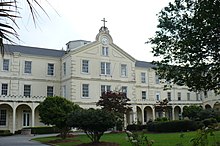Spring Hill (Mobile, Alabama)
[2][3][4] Located on a tall broad hill 6 miles (10 km) to the west of downtown Mobile, it has one of the highest elevations in the area.
[7] Overlooking the surrounding landscape, Spring Hill began to be extensively settled in the first half of the 19th century.
With the city plagued by extreme humidity, heat, rain, and yellow fever epidemics during the warm months, people began to realize that the western hills outside of the city tended to remain relatively free of fever and disease.
[8] In January 1832, construction began on an aqueduct of cast iron and wooden pipes to bring water into Mobile from a spring on the hill.
It sat amidst 20 acres (8.1 ha) on the south side of Old Shell Road and included a lake and bathing pavilion.
1893 saw the completion of an electric trolley line along Old Shell Road to the intersection of what is today McGregor Avenue.
After being destroyed by fire during the first decade of the twentieth century, a new, larger Spring Hill Hotel, with a tall central tower, was built in its place.


